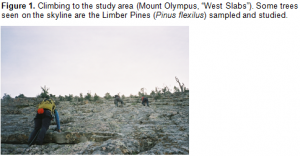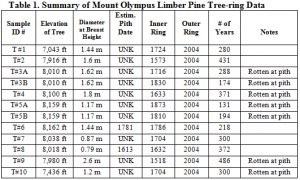Daniel F. Bently and Dr. Matthew F. Bekker, Geography
The purpose of this study was to extend the climate record of the Wasatch Front Area in order to assess drought along the Wasatch Front. In order to accomplish this, tree-ring analysis was done using Limber Pine (Pinus flexilus) trees from the rocky, north face of Mount Olympus, Wasatch Mountains.
Because of its steep slope and rock substrate, the “West Slab” area on the north face of Mount Olympus was selected to sample tree-rings. Elevations range from 7,000 to 8,200 feet on the slab. Limber Pine (Pinus flexilus) as well as Douglas Fir (Pseudotsuga menziesii) are both found growing out of the rocky quartzite face as well as many lichen species and smaller shrubs.
Approaching the site on Mount Olympus included using rock climbing equipment to ensure safety. Lead climbing and rappelling was used to get to each tree sampled because the “west slabs” area consists of a 1,200 ft. cliff face. An Increment borer was used to extract pencil sized samples of the tree’s tree-ring structure. Trees were selected based on size and estimated old age. These samples were then taken back to BYU where they were mounted with pine wood, marked, and sanded. Tree-rings were then analyzed using a microscope.
The Limber Pine trees located on the mountain’s rock face are well suited to provide accurate climate data as the water they collect is directly related to the amount of water falling each year (as opposed to a tree situated near a stream where water is available at any time).
Unfortunately, the samples from the Mount Olympus site were not as useful as originally thought before the study. 58% of the tree-ring samples used were rotten near the core, so complete data was unavailable for 41% of trees sampled. Despite the poor nature of some trees, I found the average number of usable years for each sample was 272 years. This number is 154 years longer than the human record taken since 1887 in Utah. The longest chronology was 486 years. And 50 percent of the samples had chronologies extending at least 300 years old.


The poor quality of the samples is probably due to the growing situation of the trees. Various attempts were made to build a chronology using all samples, but insecurities about ring years made an accurate chronology impossible, and therefore an assessment of drought was also not possible.
Even though the initial objective of the study was not able to be met, the findings of the study are still valuable. Similar research is underway in the Wasatch Mountains and the Mount Olympus samples have helped guide that research. Furthermore, the samples collected in this study can be used to compare with other tree-ring sites and added to their chronologies. The research experience was an invaluable part of my education. My experience helped me get accepted into graduate school where I am currently working on similar research.
Special thanks to Heather Babcock for helping me stay safe on the rocks during the study, and Matthew Bekker for his inspiration, enthusiasm, and support for the research.
